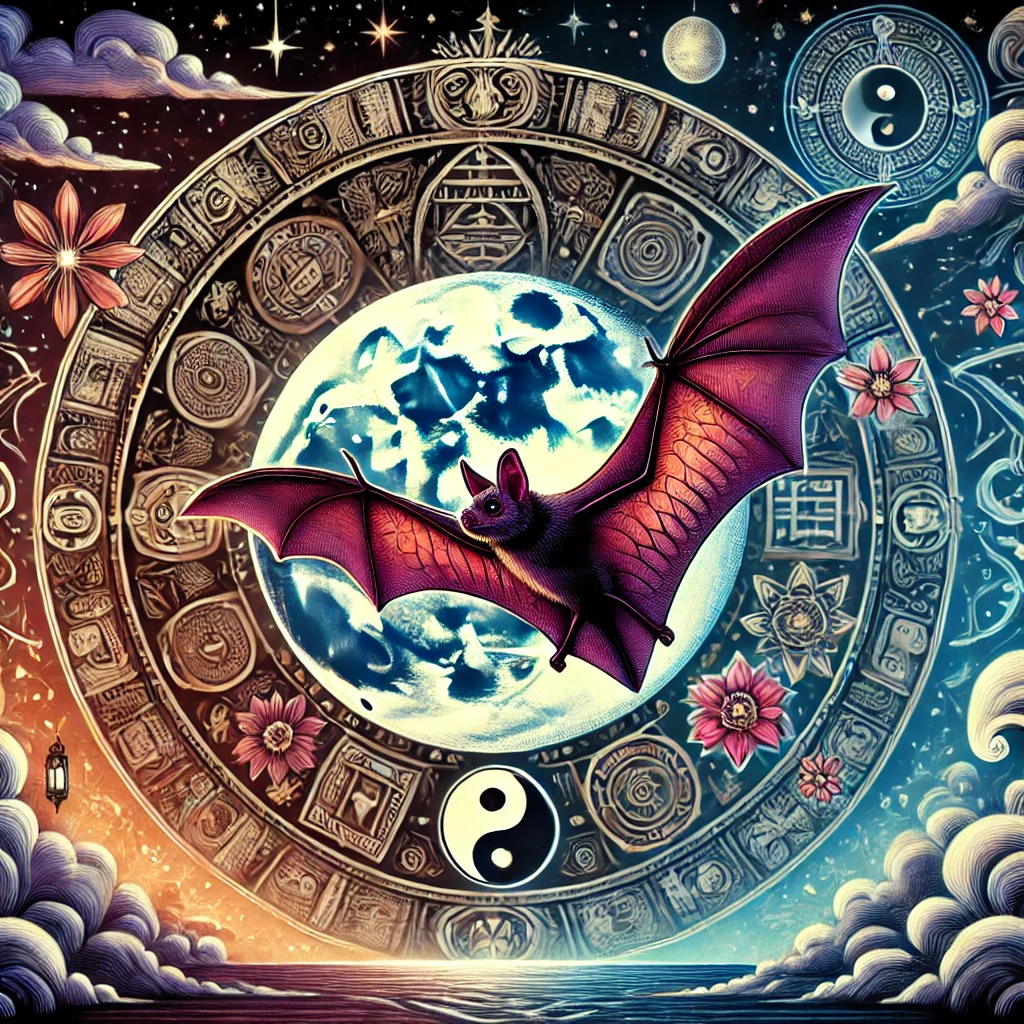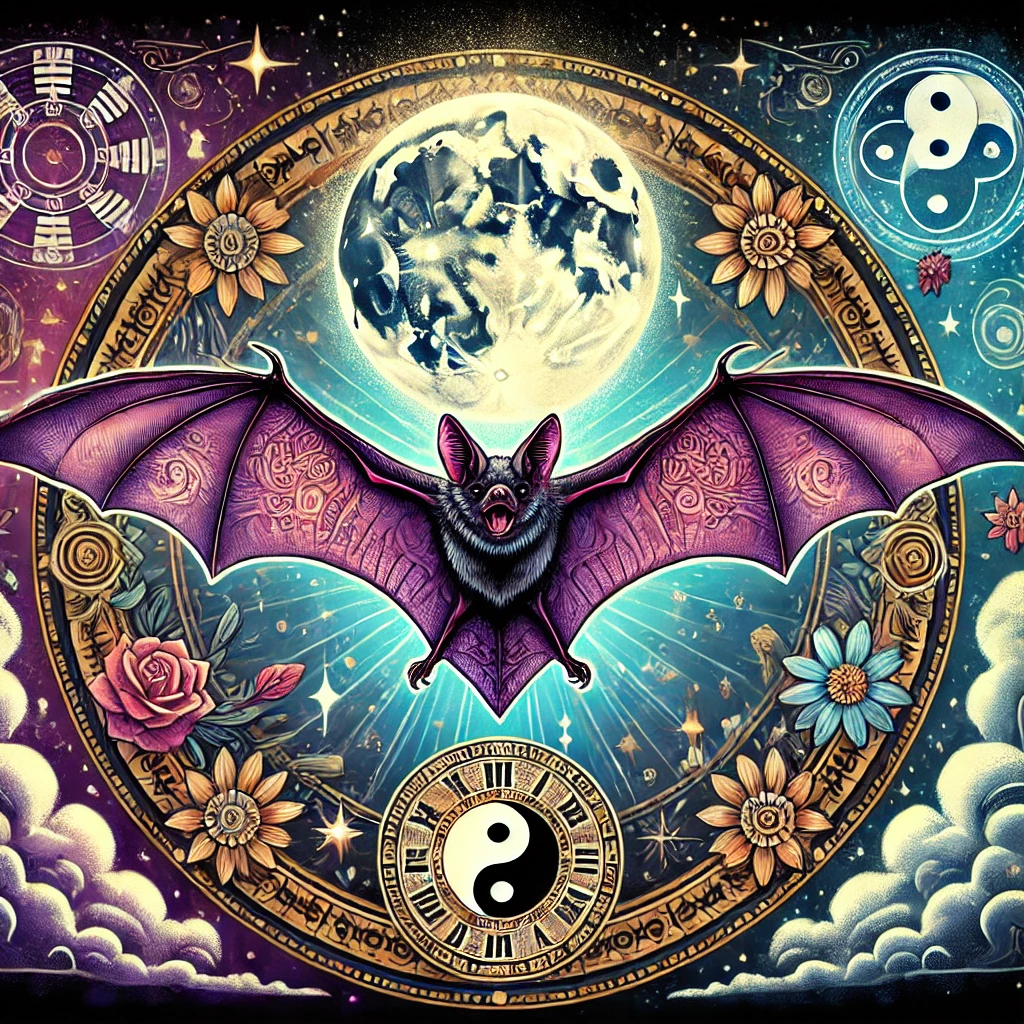The Spiritual Meaning of the bat, a fascinating and enigmatic animal, is unique among mammals for its ability to fly. Often surrounded by myths and superstitions, the bat possesses deep symbolism that extends across various cultures and eras. This detailed analysis will explore the characteristics of the bat, its cultural symbolism, the meaning of its appearance in people’s lives, and its role as a power animal.
Characteristics of the Bat
Bats are nocturnal creatures that inhabit almost every corner of the world, except in polar regions and extreme deserts. There are more than 1,400 species of bats, representing approximately 20% of all mammal species. Among their most notable characteristics are:
- Echolocation: Bats use sound waves to navigate and hunt in the dark, a skill known as echolocation. They emit high-frequency sounds that bounce off objects and return to them, allowing them to create a mental map of their surroundings. This ability is so precise that they can detect obstacles as thin as a human hair.
- Flight: They are the only mammals capable of sustained flight. Their wings are formed by a membrane of skin that stretches between the bones of the fingers and the body, allowing them to maneuver with great agility in the air. This wing structure gives them a unique flying ability, different from that of birds.
- Diverse Diet: Bats vary in their diet, from insects and fruits to small vertebrates and nectar. Some species, like the fruit bat, play a crucial role in seed dispersal and plant pollination, while others, like insectivorous bats, help control insect populations.
- Social Life: Many bats live in colonies, which can range in size from a few dozen to thousands of individuals. Colony life provides them with benefits such as protection from predators and cooperation in finding food. The social structure of these colonies can be quite complex, with hierarchical interactions and sophisticated communication systems.
Cultural Symbolism of the Bat
The bat has different symbolic connotations in various cultures:
- China: In Chinese culture, the bat is a symbol of good luck and happiness. The word for bat, “fu,” sounds the same as the word for fortune, leading to a positive association. Bats are often depicted in art and jewelry as amulets of good luck and prosperity.
- Mesoamerica: In Mesoamerican cultures, such as the Maya and Aztec, bats were considered messengers between the world of the living and the dead. They also symbolized fertility due to their role in pollination. In Mayan mythology, the bat god, Camazotz, is a prominent figure representing night, death, and sacrifice.
- West: In contrast, in many Western cultures, bats are often linked with death and the supernatural, partly due to their association with the night and vampire myths. Literature and cinema have perpetuated these associations, portraying bats as creatures of darkness and mystery.
Meaning of the Bat’s Appearance in Your Life
The appearance of the bat’s spiritual meaning can carry several important messages:
- Transformation and Change: Similar to the Hanged Man card in Tarot, the bat symbolizes a new perspective and the beginning of significant change. Hanging upside down can be seen as an invitation to change our way of seeing the world. This inverted posture encourages us to reevaluate our beliefs and open ourselves to new possibilities.
- Rebirth: Bats, which appear at dusk, symbolize the transition between death (night) and life (day). They indicate that a period of renewal is on the way. This daily cycle of activity suggests that there is always an opportunity to start anew, regardless of the challenges we face.
- Intuition and Perception: The bat’s echolocation ability suggests that we should trust our inner senses and intuition to navigate times of uncertainty. This ability reminds us that we have internal resources that can guide us through darkness and help us find our way.
The Bat as a Power Animal
Having the bat as a power animal offers a series of characteristics and abilities that you can incorporate into your life:
- Adaptability: Bats are extremely adaptable to different environments and situations. As a power animal, it teaches you to be flexible and adjust to changes without losing your way. This adaptability can be a source of strength in times of change and challenge.
- Exploration of Darkness: With the bat’s guidance, you can learn to face your fears and explore the dark areas of your psyche. It is a reminder that there is growth and discovery in darkness. By confronting our shadows, we can discover hidden aspects of ourselves and achieve greater self-knowledge.
- Communication and Relationships: Bats are social creatures that live in large colonies. They can teach you the importance of community, cooperation, and effective communication with others. Colony life demonstrates how cooperation and mutual support can be beneficial for all members.
- Protection and Nurturing: Despite their appearance, bats are protectors of their environment, controlling insect populations and pollinating plants. As a power animal, it helps you be a protector of your environment and nurture your relationships. This ability to protect and nurture symbolizes the balance between giving and receiving in our interactions with others.

The Bat in Mythology and Spirituality
The spiritual meaning of the bat has played a significant role in the mythology and spirituality of many cultures:
- Mayan Mythology: The bat god, Camazotz, is an important figure in Mayan mythology, symbolizing night, death, and sacrifice. The Maya saw bats as guardians of the entrance to the underworld, and their image is present in many ancient texts and monuments.
- Australian Aboriginal Cultures: Bats are seen as protective spirits that guide the souls of the deceased to the afterlife. In Aboriginal creation stories, bats play crucial roles as messengers and protectors, connecting the world of the living with the spiritual world.
- Shamanic Traditions: In shamanism, the bat is seen as a spiritual guide that helps shamans travel between worlds and gain wisdom. Shamans may invoke the spirit of the bat for guidance in their spiritual journeys and to receive protection in the spirit world.
Personal Reflection and Application
The bat invites us to reflect on our own shadows and fears. Integrating it as a spiritual guide allows us to learn to navigate internal darkness with confidence and wisdom, transforming our challenges into opportunities for personal growth.
- Facing Fears: The bat encourages you to face your fears and seek the meaning behind them. By confronting our shadows, we can find the strength and resilience to overcome any obstacle.
- Change and Adaptation: It teaches you to embrace change and be flexible in adverse situations. The bat’s adaptability reminds us that change is a natural part of life and that we can thrive in new circumstances.
- Intuition and Perception: It reinforces the importance of trusting your intuition and internal perceptions. Just as the bat relies on its echolocation to navigate in the dark, we can learn to trust our instincts to guide us in times of uncertainty.
The spiritual meaning of the bat, with its rich symbolism and profound spiritual significance, offers us valuable lessons about transformation, adaptability, and intuitive perception. Recognizing and honoring the bat as a power animal can enrich our lives, giving us the ability to face darkness with courage and emerge with a renewed perspective and inner strength.
More Reflections on the Bat
The Bat and Personal Transformation
In many spiritual traditions, the spiritual meaning of the bat is seen as a symbol of transformation and change. Its ability to fly and its nocturnal life make it an emblem of transition and rebirth. Seeing a bat can be a message that it is time to leave behind old habits and embrace new opportunities.
The Bat in Traditional Medicine
In some cultures, the spiritual meaning of the bat has been used in traditional medicine. Its parts have been employed in remedies to treat a variety of diseases and conditions. Although these practices may seem strange, they reflect the deep respect and connection these cultures feel towards the bat.
Stories and Legends of the Bat
Stories and legends about bats are countless and vary from one culture to another. From vampire tales in Western literature to stories of bat gods in Mesoamerican mythology, these animals have captured human imagination for centuries.
Conservation of Bats
Today, bats face numerous threats, including habitat loss, hunting, and diseases. The conservation of these creatures is crucial not only for their ecological importance but also for the rich symbolism and spiritual connection they have with us.
Conservation Actions
- Habitat Protection: Conserving the forests and caves where bats live is essential for their survival.
- Education and Awareness: Informing the public about the importance of bats and dispelling negative myths can help protect these species.
- Scientific Research: Supporting research on bats and the diseases that affect them can lead to better conservation strategies.
Ecological Importance: Bats play vital roles in ecosystems, from pollinating plants to controlling insect pests. Their disappearance would have a significant impact on the natural balance and agriculture.

The Bat in Art and Culture
The spiritual meaning of the bat has inspired artists, writers, and filmmakers throughout history. Its image has been used in various forms of cultural expression, from ceremonial masks to horror films.
Artistic Representations
In art, the spiritual meaning of the bat often symbolizes mystery and the unknown. Artistic representations of bats can be found in paintings, sculptures, and cultural artifacts worldwide.
Bats in Literature
Literature has used the figure of the bat’s spiritual meaning to explore themes of darkness, transformation, and fear. Works like Bram Stoker’s “Dracula” have cemented the association of bats with vampires and terror in popular culture.
🌟 Core Characteristics
- Flying Marvel: Only mammal capable of true flight
- Night Navigator: Masters of echolocation
- Social Beings: Live in complex colony structures
- Diverse Diet: From fruits to insects to nectar
- Global Presence: Found everywhere except polar regions


